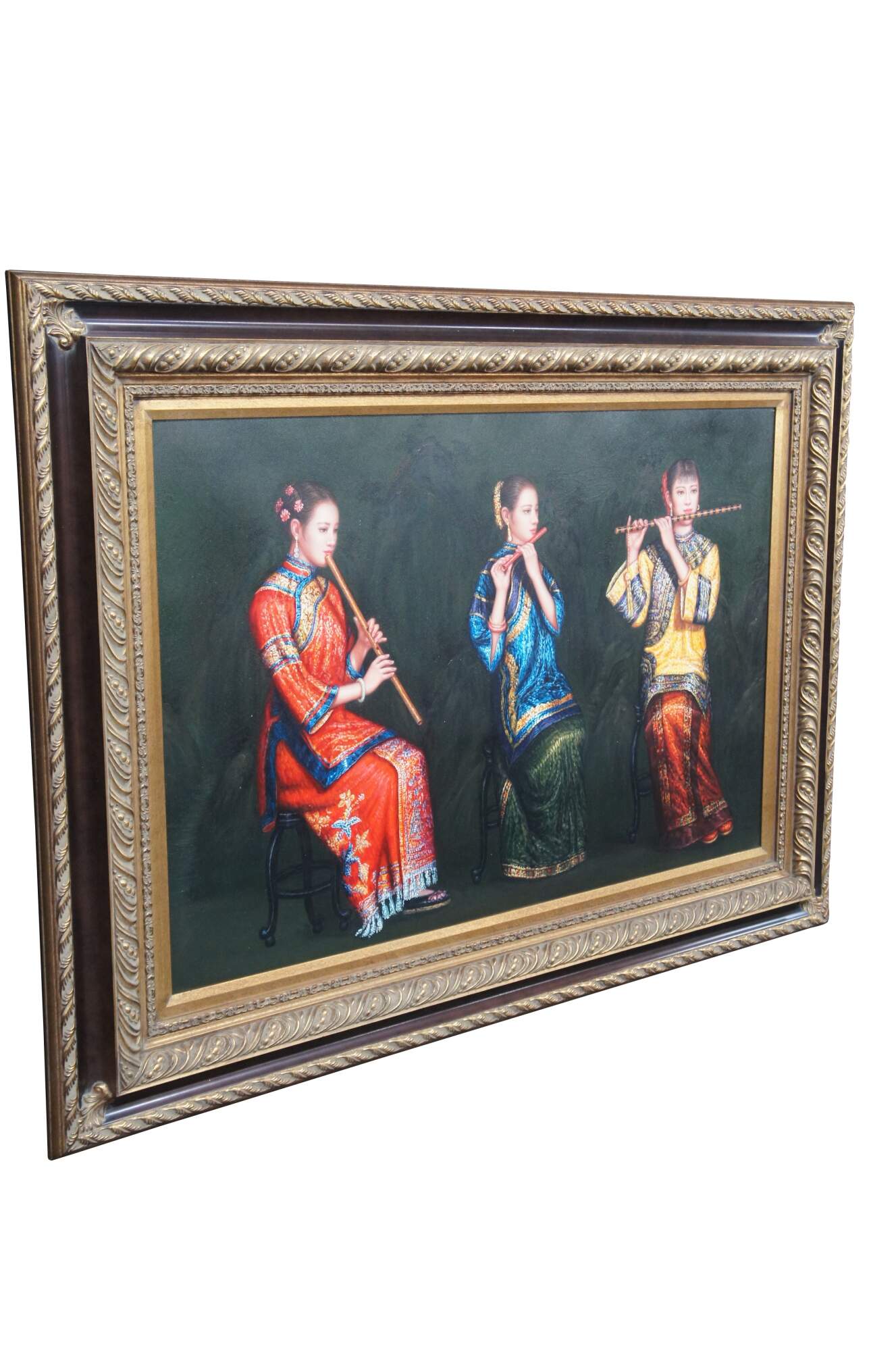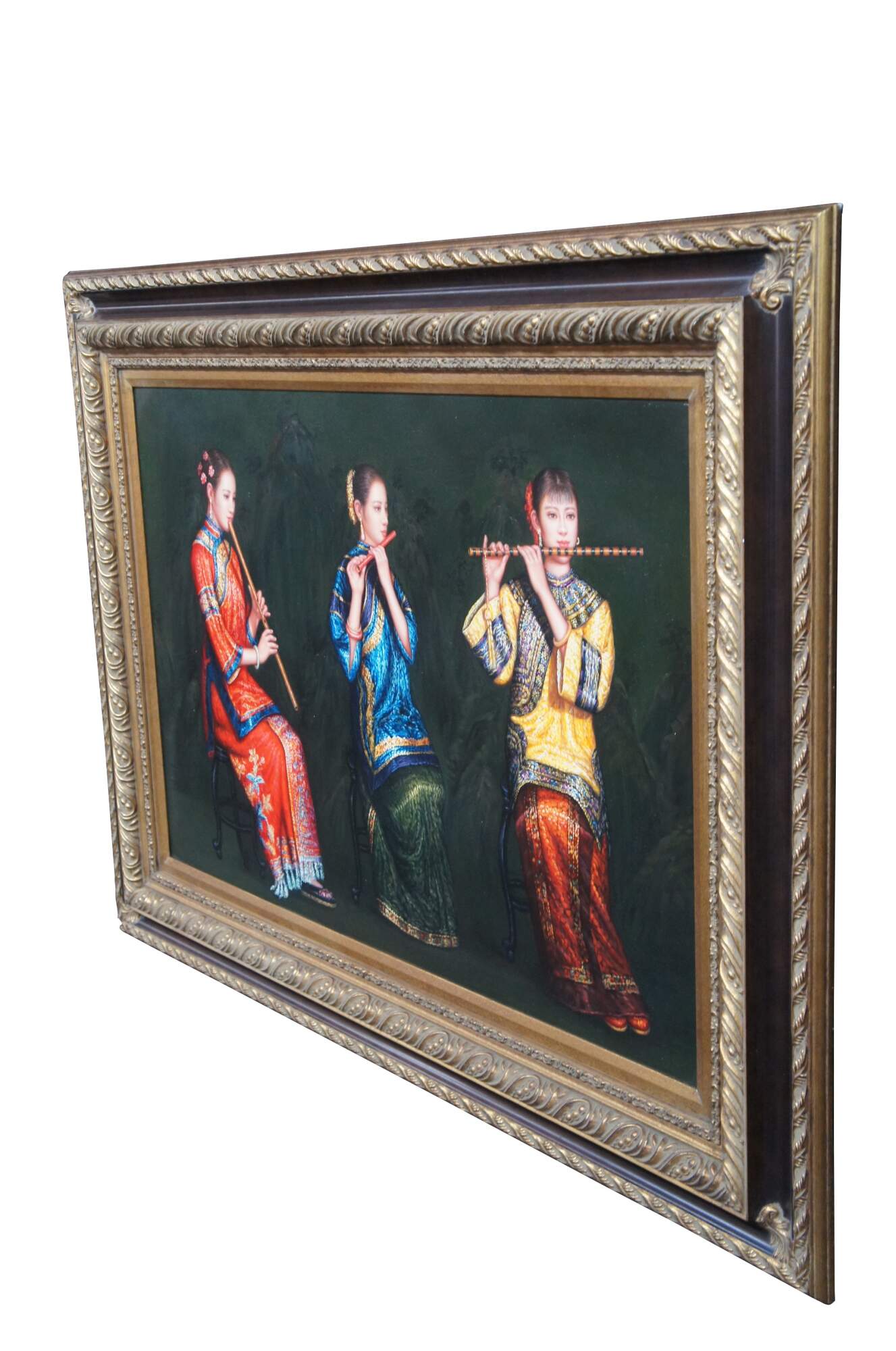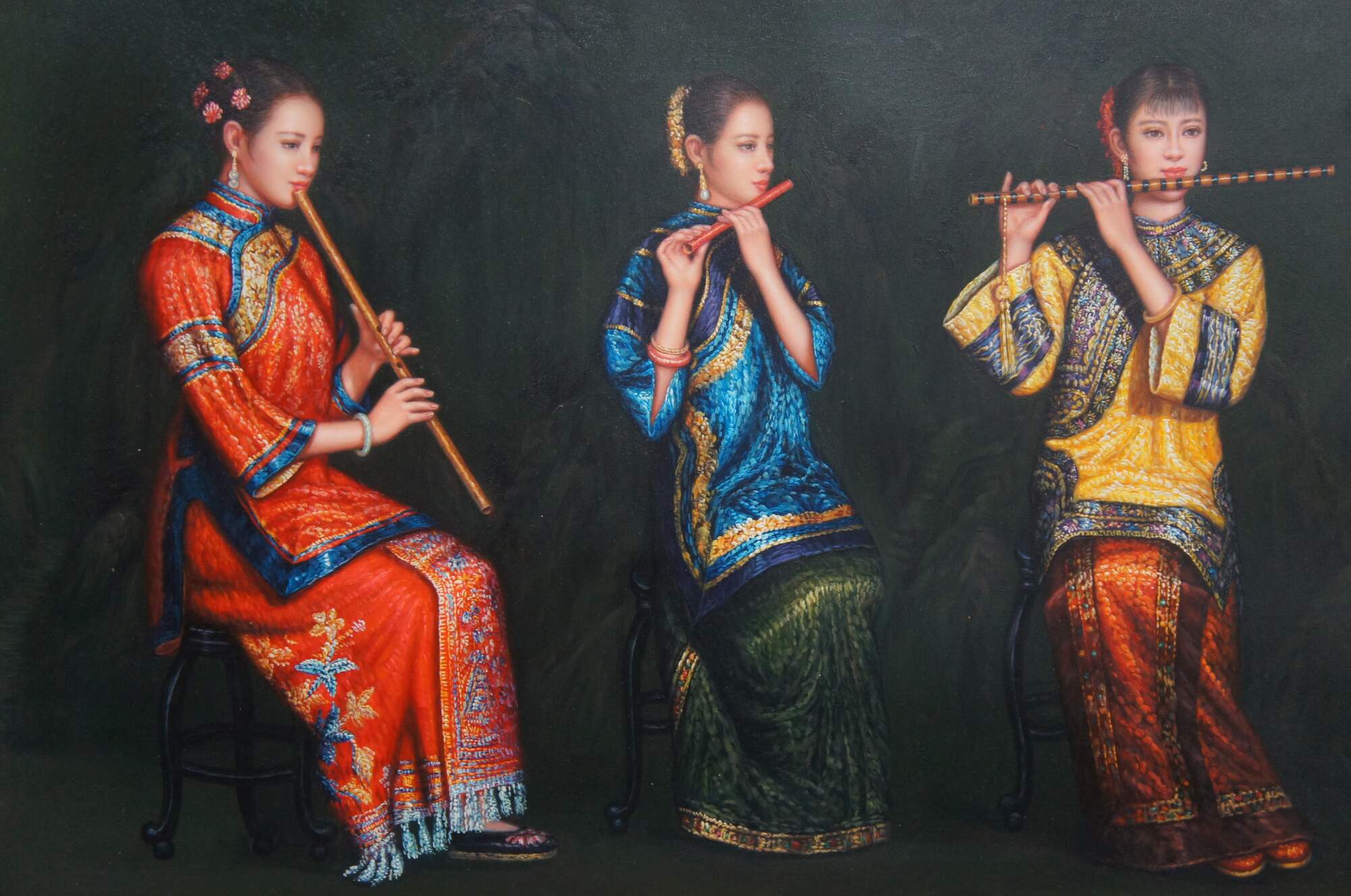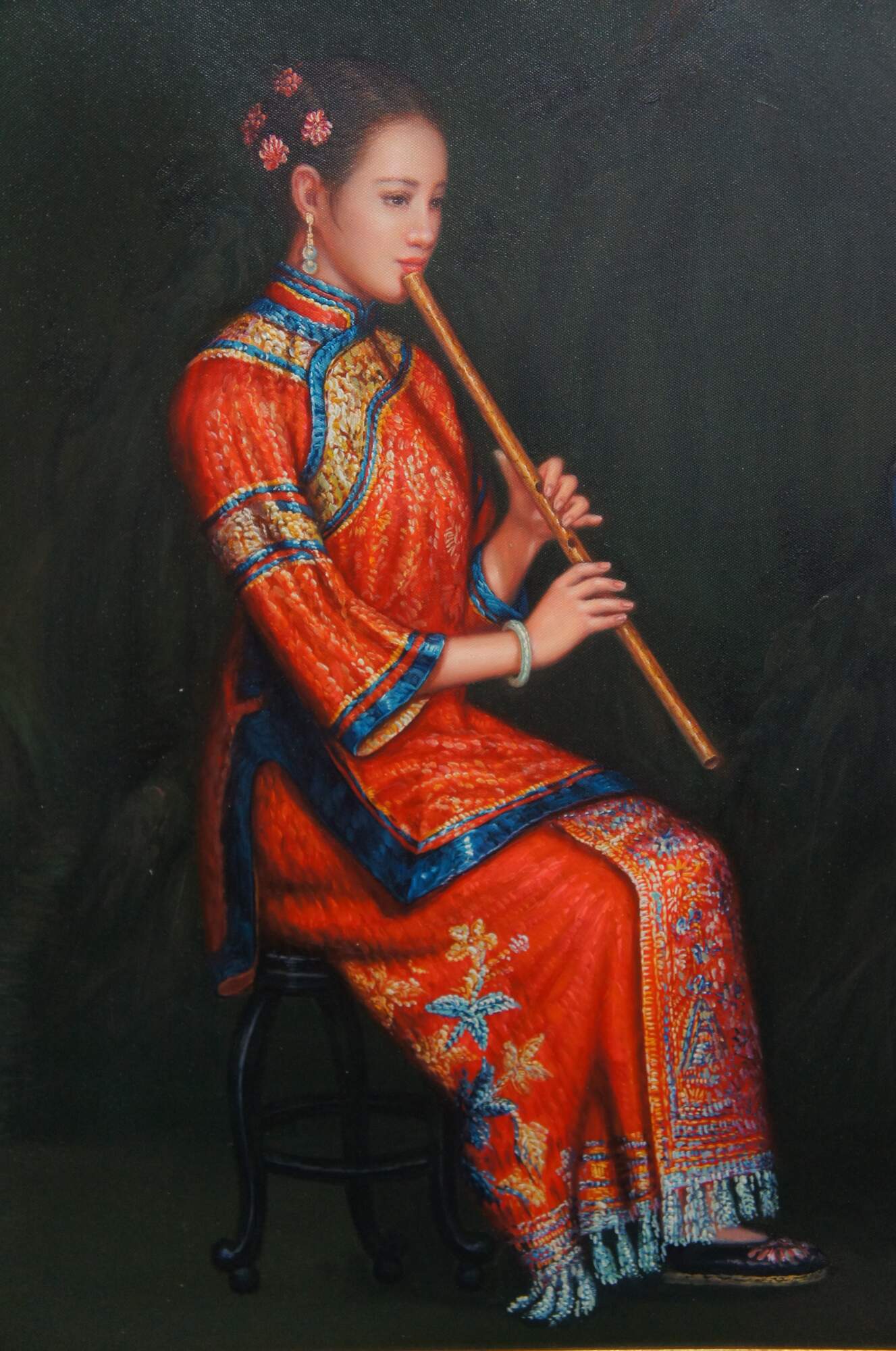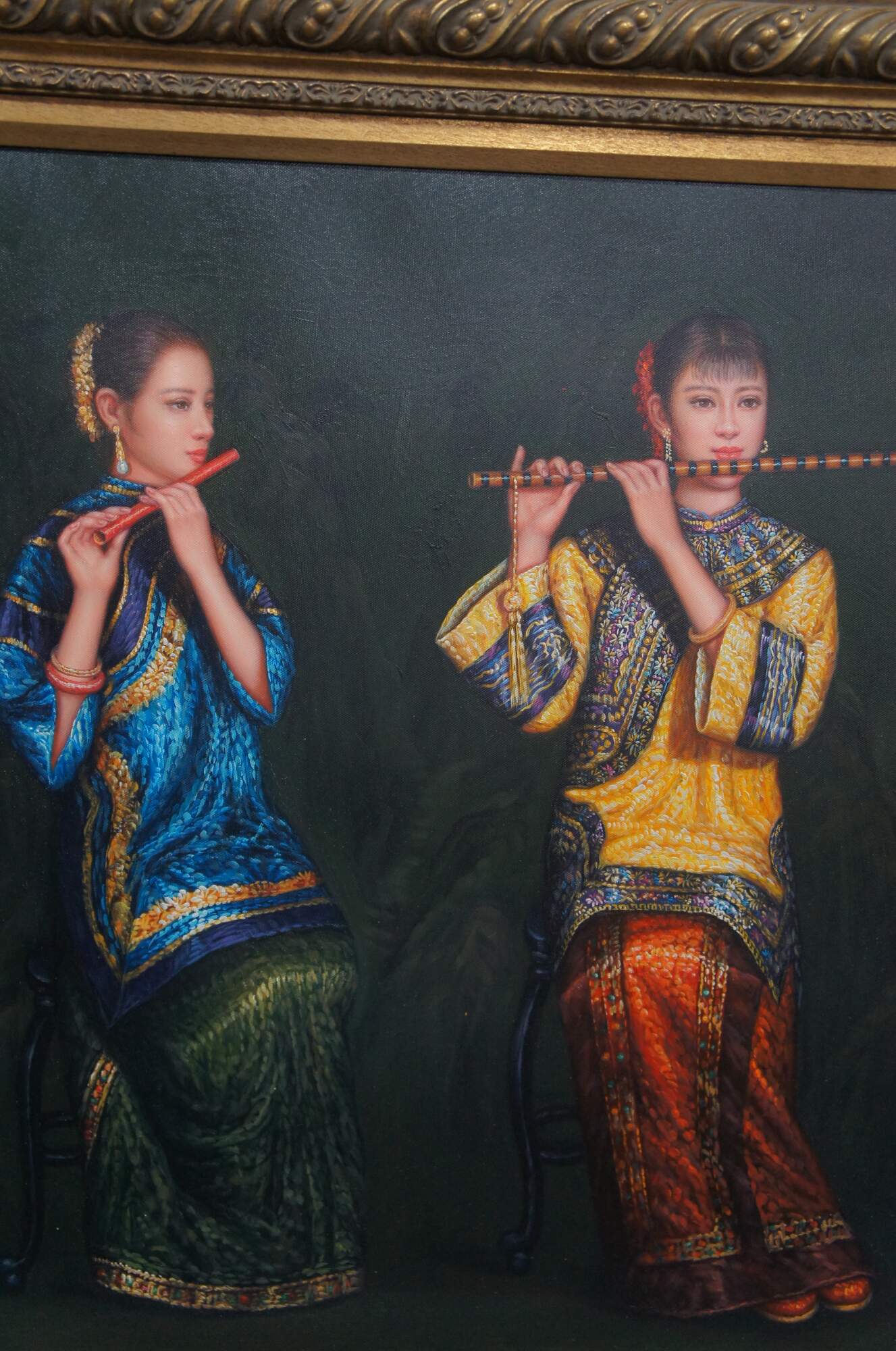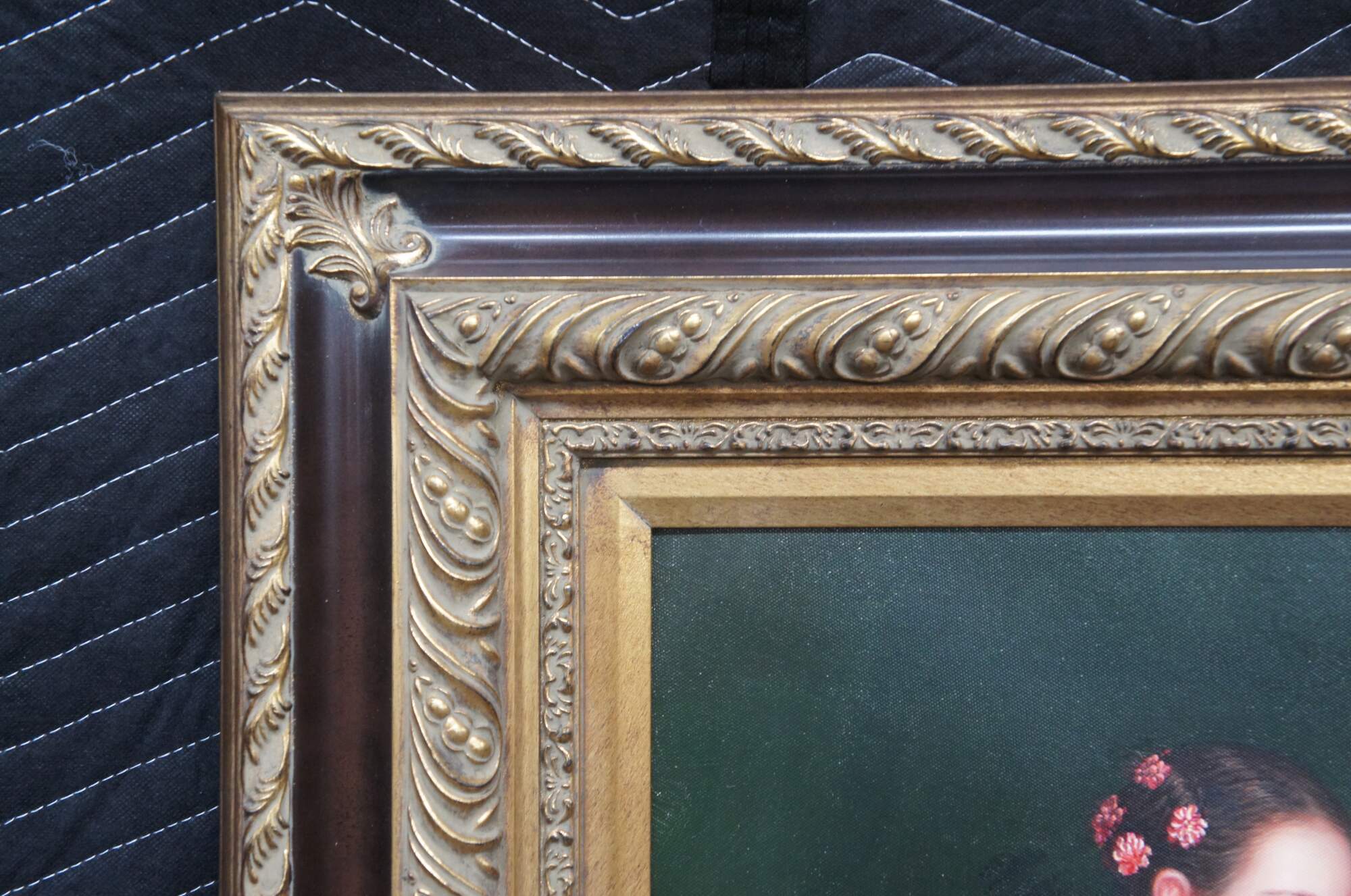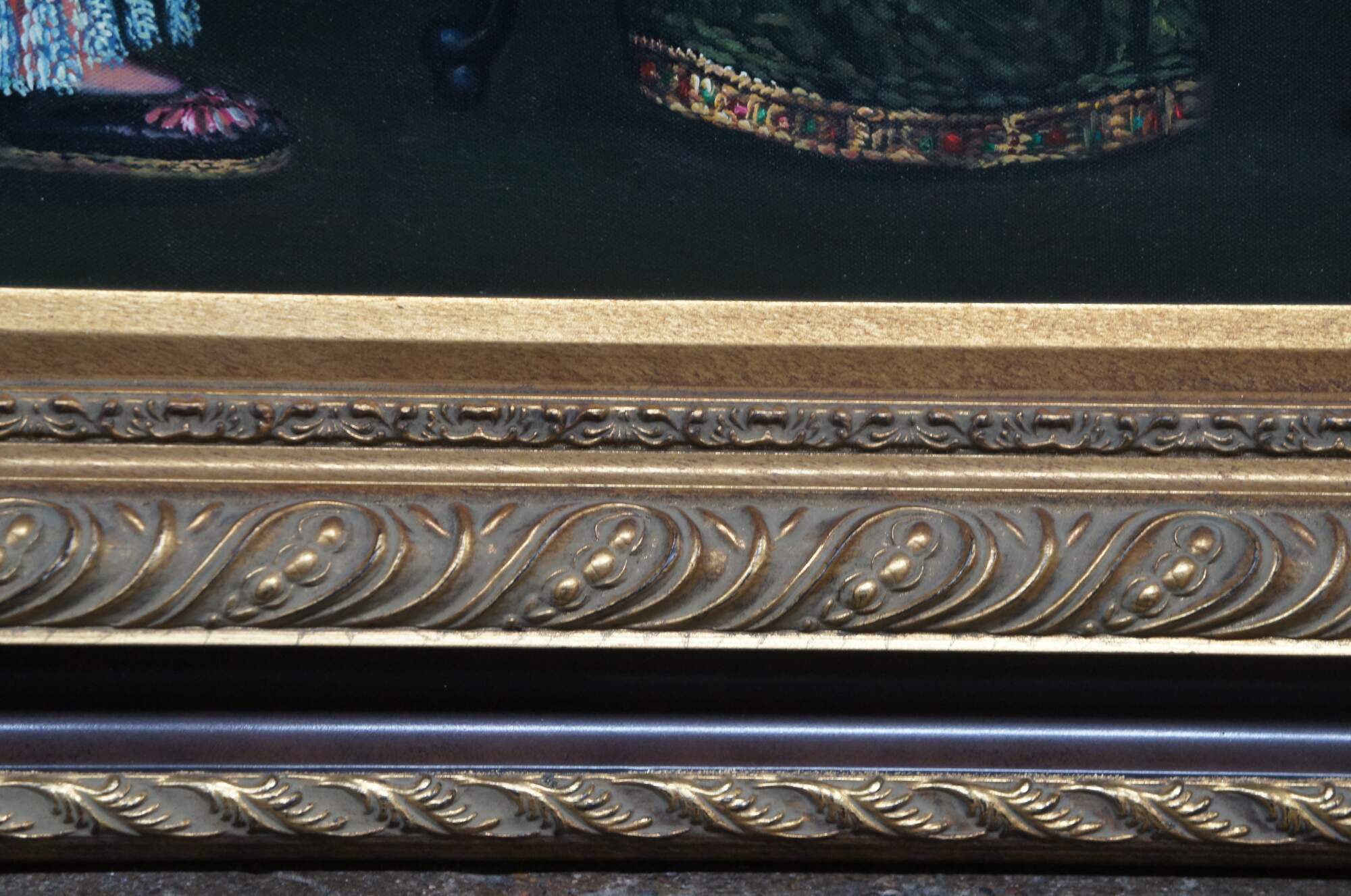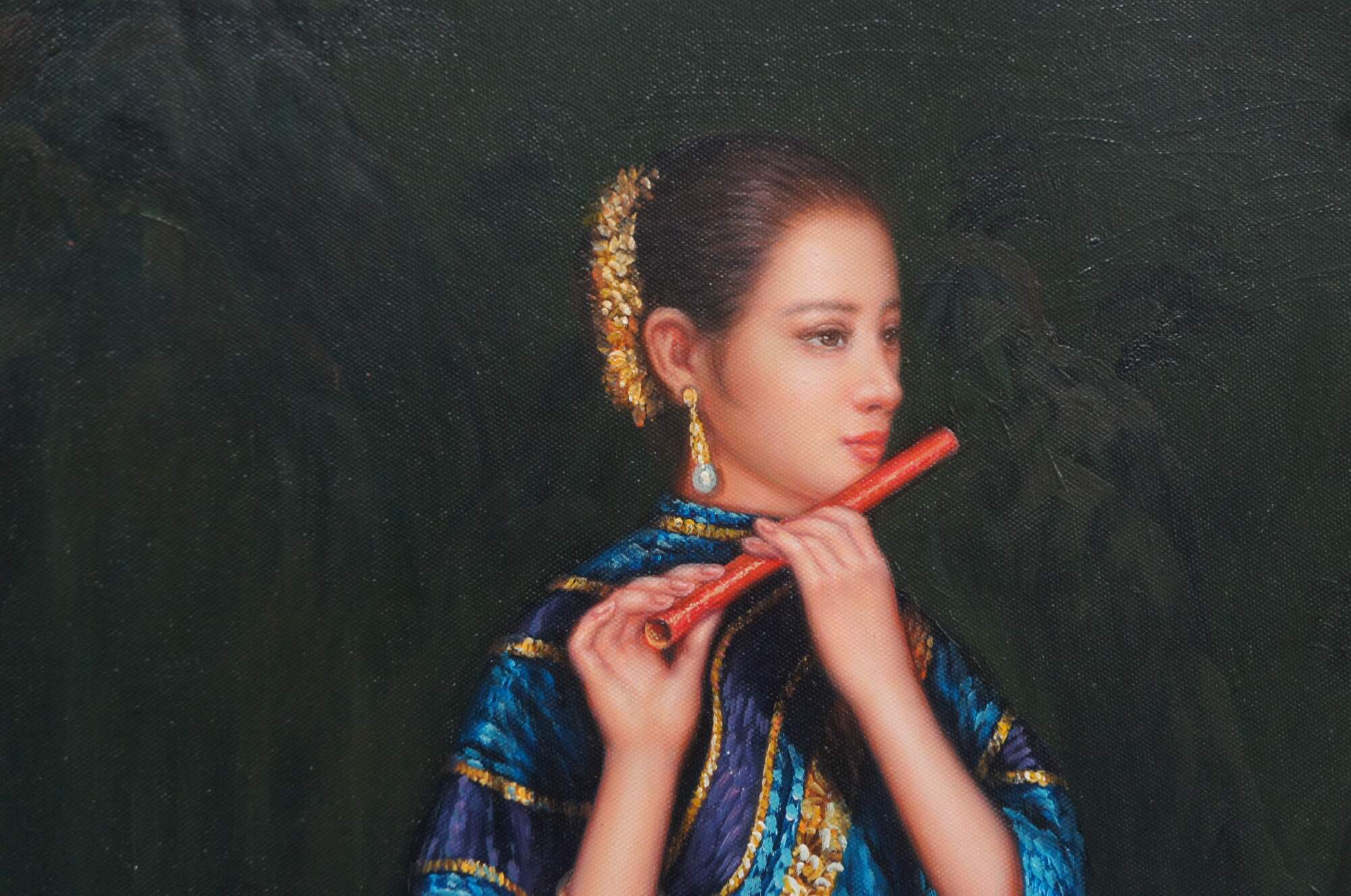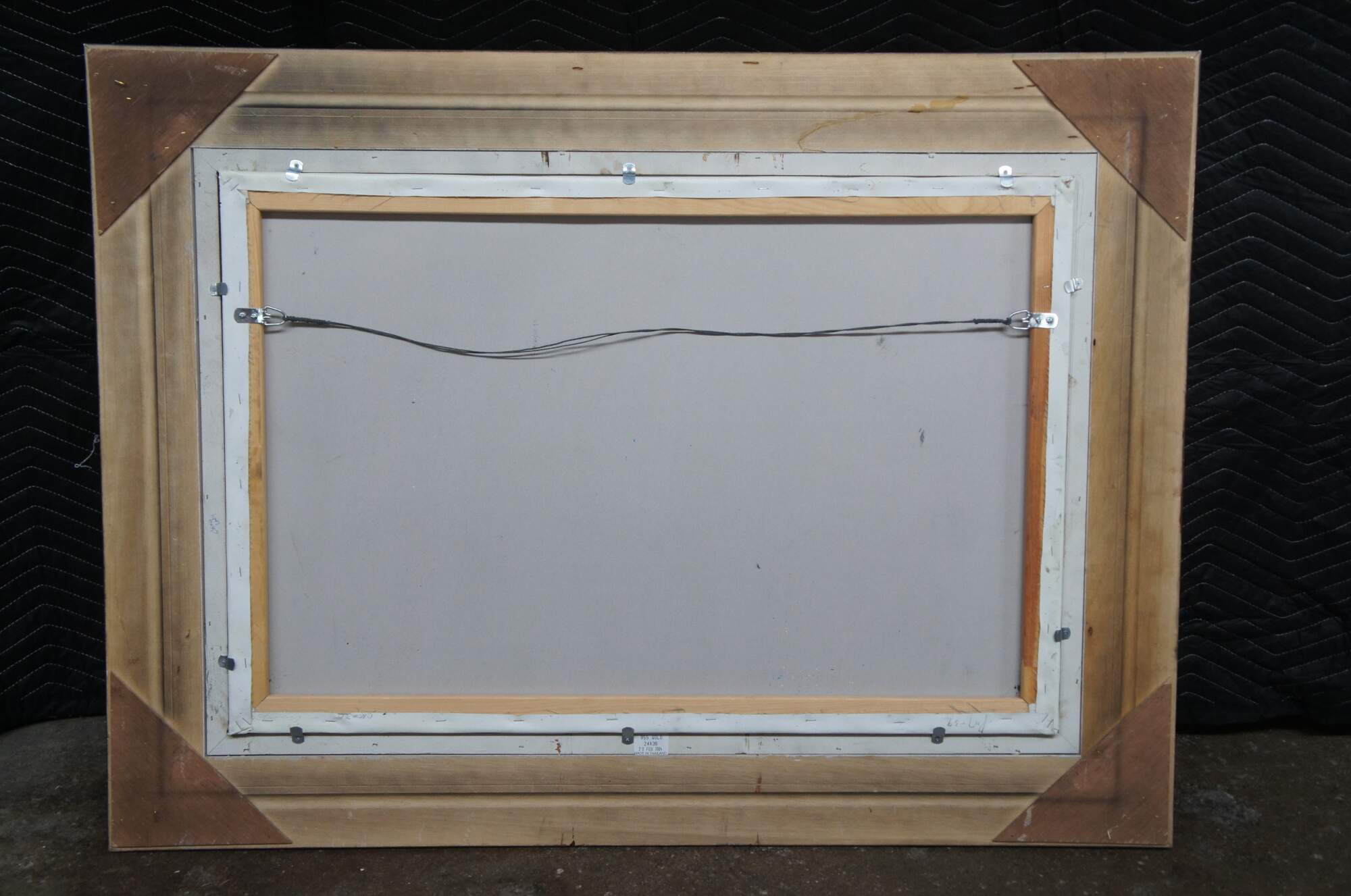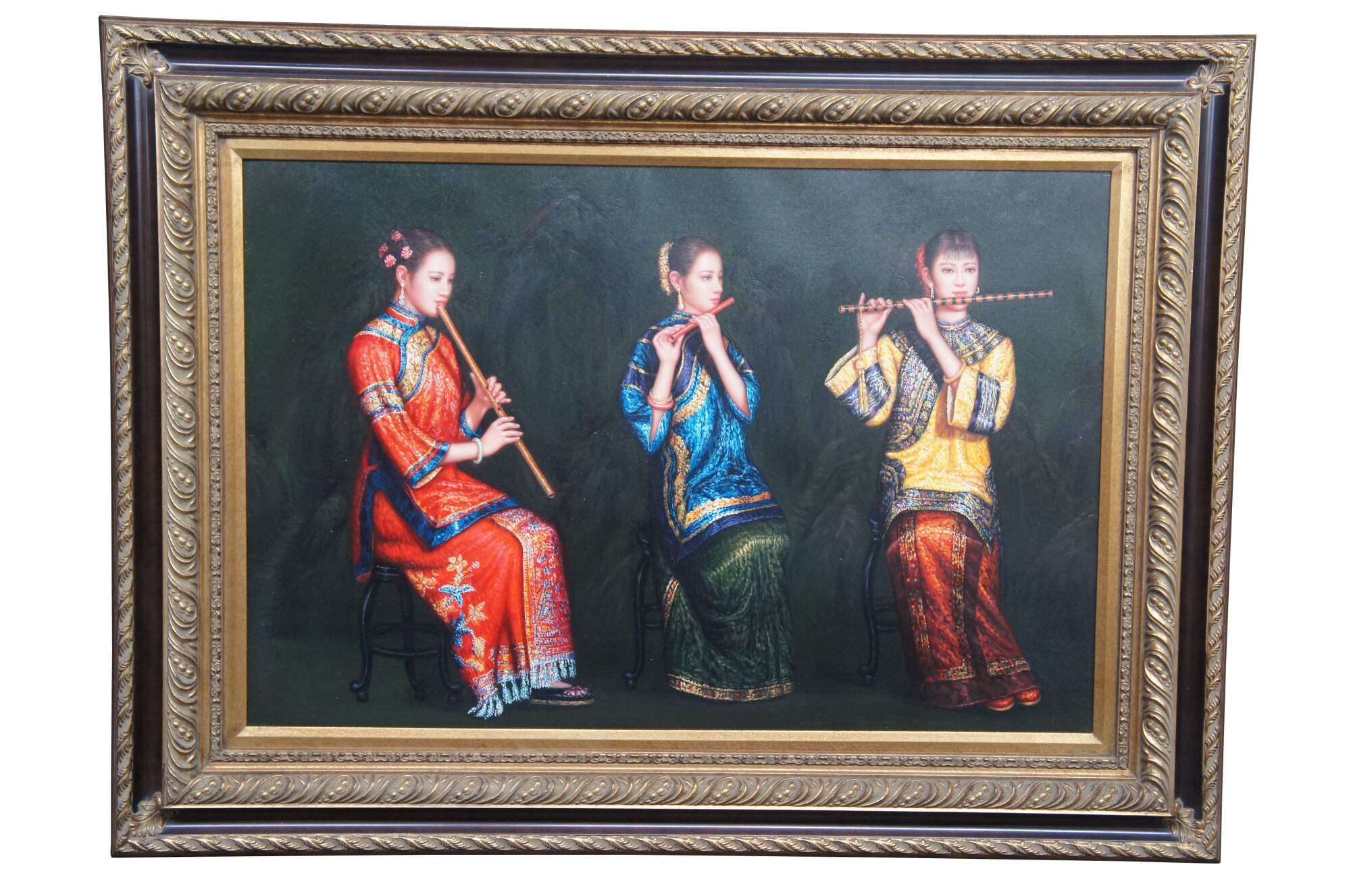
Chinese Trio of Woman Playing Bamboo Flutes Oil Painting After Chen Yifei 46"
$940.00
Shipping:
Free Shipping Included
Delivery:
Estimated 2-15 Business Days
Payments:
Credit Card, Check, Cash, PayPal, Apple Pay, Venmo
Returns:
30 Days 100% Money Back Guarantee, Buyer Pays Return Shipping
Description
Vintage trio of Chinese woman playing flutes oil painting on canvas after Chen Yifei. Features three young musicians in traditional court attire playing the Dizi / bamboo flutes.
Chen Yifei (Chinese: 陈逸飞; April 12, 1946 – April 10, 2005) was a renowned Chinese classic-style painter, art director and film director. He has made many films such as The Music Box and Inyak Twilight.
Achievements
Chen Yifei is a central figure in the development of Chinese oil painting. He is also considered one of China's most renowned contemporary artists.[citation needed] Although denounced for "capitalist behavior", Chen's work with oil painting earned him recognition from Chinese authorities.
Chen soon became one of the leading painters of the Cultural Revolution. He was famous for his Mao Zedong portraits and depiction of grand heroic events of the modern Chinese nation. Since the Cultural Revolution, Chen became the forerunner of a new age in Chinese aesthetics, promoting a new sense of modernity and lifestyle in his paintings, including fashion, cinema and design. In his oil paintings, Chen abandoned his uncritical glorification of the party to blend realistic technique and romanticism with Chinese subject matter, especially melancholic and lonely women in traditional dresses. His characteristic "Romantic Realism" paintings use dark and dense colors and convey a sense of richness and integrity.
In 1980 he became one of the first artists from the People's Republic of China permitted to study art in the United States. Wally Findlay Galleries was the first gallery to grant Chen Yifei an exclusive contract. Chen Yifei enrolled at Hunter College and later found work as an art restorer. In 1983, before he attained his master's degree at Hunter, his solo exhibition at the Hammer Galleries was a great success. Later, he established himself as a contract artist for the Hammer Galleries.
Chen returned to China and settled in Shanghai in 1990. He painted Impressionist landscapes of Tibet and his native Zhejiang Province. At the same time, he had also transformed himself into a style entrepreneur, creating fashion brands, decorating hotels and selling high-end clothing and chic home furnishings. He also supervised one of the country's biggest modeling agencies. Some critics said he turned increasingly commercial. In 2005, while working on a feature film, "Barber," Chen fell ill and died.
Style and content
Chen worked primarily in oil painting which portrayed his sense of romanticism and realism combined. His works frequently featured beautiful women in traditional Chinese attire working with musical instruments or other romanticized objects. There are many examples of this brand of paint including Young Cellists (1984) and Two Women and Fan (2003). Other works featuring Chinese women in traditional clothing include Beauty (Blue/Red) (1998), Beauty with Fan (2002), Group of Beauties with Fans (2004), Seated Beauty with Fan (1998), and Reclining Beauty (1997)[5] The realism of Chen's works often evokes a photographic or cinematic feeling, inspired by the framing, lighting and positioning of the paintings.
In addition to painting the female form, some of Chen's earlier works were often more impressionistic landscape paintings done in his style, such as his piece Shadow from 1983 in which a scene of a canal in absence of human life is painted in muted tones. Chen first received inspiration for these works when he travelled to Europe in the summer of 1982 and toured the canals, noting similarities in the ambiance between the East and West. He later returned to Zhejiang and studied, what he considered, the "Venice of the East" for more inspiration.[6] His landscapes often featured similar scenes of canals inspired by the canals of Venice, Italy as well as the canals of his hometown in Zhejiang province.
"Official" art
Chen's artistic career began soon after graduating from the Shanghai College of Art when his realistic style of oil painting caught the attention of Communist officials. Chen painted many famous portraits of Mao in heroic, glorified positions. One of these works, Seizing of the Presidential Palace (1977) received great favor in the Communist party, earning a place in the great halls around China. The picture is a historical epic depiction of a group of soldiers raising a red flag, representative of the history of the Revolution. His work Eulogy of the Yellow River, completed in 1972, is still considered one of his most commercially successful works, featuring his singular techniques in expressive brushstrokes that create a realistic view of a soldier standing above a yellow-toned valley, turned to face the viewer. The work was originally inspired by a poem (written by Guang Weiran) and a song (composed by Xian Xinghai).[6] The work was first presented to the public in 1977 at the United Armies Art Exhibition when Chen was 25 years old.[7] The revelation of this work marked a pivotal point in Chen's artistic career, propelling his art into further success in the future. In 2007, two years after the artist's death, Eulogy of the Yellow River sold at The China Guardian 2007 Spring Auction of Oil Painting and Sculptures for a record high of RMB 40.28 million, breaking both Chen's previous world record high sale and the national record for Chinese oil paintings.[7]
In 1979, Chen painted Looking at History from My Space, a piece that critics consider Chen's work considers "one of his most original works".[1] The painting features the artist standing in front of a large mural of painted events from the 1910s and 1920s, symbolically representing the artist trying to distance himself from history, to examine his place in history.
Realism
Along with his predilection for painting women, Chen painted a series of realistic works featuring people of Tibet; the series was called "Tibet." To gather intelligence and insight into the people and customs of Tibet, Chen spent some time in the 1980s exploring Jiangnan. The works that followed his excursion held to his highly realistic brand of paint, but traveled away from only painting the most beautiful forms of life. His "Tibet" works feature the tanned and coarse Tibetan people with no pretense of activity and muted expressions.[6] One of the most famous works from this series was called Upland Wind (sometimes called Wind of Mountain Village) and was painted in 1994. The painting features a family of Tibetan travelers, heavily clothed and layered (to convey a sense of coldness) in traditional Tibetan styles. The painting was initially auctioned at the China Guardian 1994 Autumn Auctions, selling for a record-high price of 2.86 million Yuan. At the time, this was a record for Chinese oil paintings. In May 2011 the painting was auctioned off for 81.65 million Yuan, beating the record again for highest-selling oil painting as well as beating his record for highest-selling work.[8]
Acclaim and criticism
His works are considered a unique combination of both Western and Eastern influences. Chen's style combines the realism associated with European art styles, with Eastern subject matter and themes close to the artist's history. One such example of this unique blend is his painting Poppy which derives its content from a Tang dynasty song about a woman who solemnly questions her fate. The painting features a Chinese woman in traditional Chinese garb, yet the style of painting coupled with her posture is more reminiscent of ancient Greek artworks than Tang dynasty works. His Eastern-Western fusion of artistic styles is apparent in another of his famous paintings called Soiree, which depicts Chinese musicians in traditional apparel, symbolizing an Eastern theme, but the atmosphere of the painting aligns more with the Western ideal of "carpe diem".[clarification needed][4]
Critics of Chen's work comment that his works lack an edge possibly due to his commercialization. Chen, however, viewed his entrepreneurship and businessman-like approach to art as an extension of what he truly loved: beauty. In answering a question regarding his work, Chen is quoted to have said: "I love paintings, clothing and films because they are all beautiful things".[9]
Condition
Very good.
Dimensions
33.5" x 45.5", sans 24" x 36"
